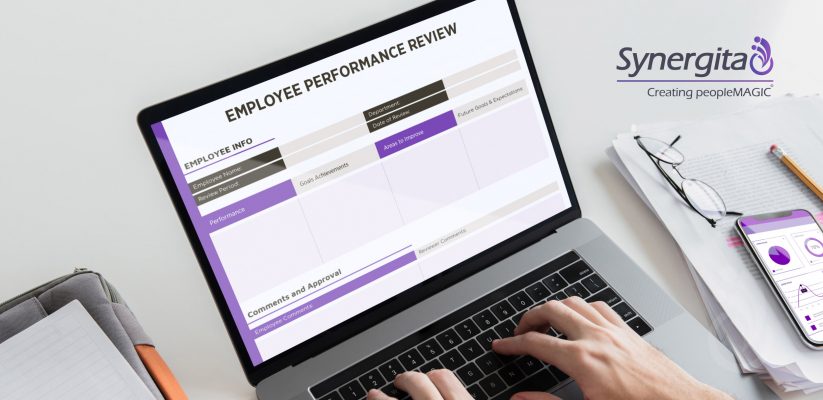Employee Performance Review Templates for Performance Appraisal
The objective of an employee performance appraisal is simple – it is to gauge if the employee is performing their duties as expected and how they are performing their tasks. These broad categories determine if the employee and the organization are aligned in their objectives. However, the results of this evaluation may not be accurate if it is done annually or in an arbitrary informal manner. Therefore, organizations have moved on to using tools and technology to redefine the appraisal process and have become adept at deriving results that ensure that the employee and organization’s growth trajectory is progressing smoothly. To make it even easier on organizations, and HR, in particular, software solutions come with templates to refine the review process.
The Performance Review Process
There are a few key components to the review process. While it may differ slightly according to the evaluator and the period of evaluation, it is still essential to have a few basic parameters. For instance,
Employee’s strengths
A review is not a way to point out failures. It is a way to offer feedback. It would be best to start with feedback and praise for a job well done. It could be related to the task, attitude, communication, or problem-solving abilities. Whatever the parameters, feedback is best started with employees’ strengths.
Employee’s weakness
Again, providing feedback on the employee’s weaknesses is an opportunity to discover areas of improvement. These areas could include the employee’s ability to collaborate with peers, communication with the team and customers, and attitude to feedback. It gives the manager an insight into their need for help in specific areas. It is also an opportunity to chart a closer mentorship if needed.
Rating process
Performance appraisal systems must include a rating system based on well-defined parameters. Instead of the traditional meeting or exceeding expectations, which could be perceived as judgmental, the system could have a numbered scale. For instance, 0-10, with ten being the highest to measure against pre-set expectations. This system is more effective in measuring technical and communication skills and potential for leadership. They are measured against specific examples from the employee’s performance.
Review period
Annual reviews are outdated because they tend to overlook performance in the beginning and focus on the period closer to the date of the review. Moreover, the employee may be under pressure as the date draws near. Quarterly reviews have become more common among organizations in all industries. It allows them to step in and course-correct if needed. It also helps the employee stay on track when someone steps in to give feedback immediately rather than later.
SMART goal-setting
For a performance appraisal to be truly effective, employees must clearly know their goals and the organization’s goals. SMART goal-setting is specific, measurable, achievable, realistic, and timelines. It will help employees stay focused and keep track of their contribution towards their goals. OKRs (objective and key results) are more in line with goals and expected outcomes.
While the above aspects of a performance appraisal system are essential, other factors are probably less easily measurable, such as individual aptitudes and skills. However, these can be assessed on a different scale.
Performance Appraisal Templates
The need to reduce human errors and make performance appraisals more objective and efficient proved to be a catalyst to drive organizations to adopt modern appraisal solutions. These software products come with inbuilt features such as employee feedback surveys, user-friendly interfaces to add employee recognition and rewards, with a single dashboard providing performance reports.
They also ensure a high level of employee engagement and continuous performance improvement. When an organization introduces excellent visibility and transparency, employees develop a measure of trust and are more motivated. The inbuilt templates ensure accurate appraisals through an intuitive interface.
- Performance review templates can be individual or team-oriented. Managers get deep insights into their direct reports’ performance.
- 360-degree feedback offers self-appraisal, peer-feedback, and manager-feedback forms that can be circulated for a comprehensive evaluation. Any disparity among the three types of feedback is the result of perception seen in self-appraisal, thereby making it easier to address a specific point of difference.
- Goal-setting reviews focus on the expected objectives. It includes the individual’s goals and how they align with the organization’s long-term goals. These templates will follow the SMART goal-setting format to make it specific and realistic.
- Professional development reviews are closely linked with performance improvement. They help employees view their contributions as against the organization’s expectations. Areas of improvement shed light on the need for learning and development.
Conclusion
Performance reviews are an ideal way to measure employee performance, and they provide employers with data to analyze their performance in the market. While organizations are working to keep pace with their competition, they also realize their core vision of engaging a growth culture through a well-structured, templatized performance appraisal system.
Also Read: Benefits of Self-Assessment in the Performance Appraisal Process
Also Read: Performance Appraisal Methods That Boost Employee Performance
